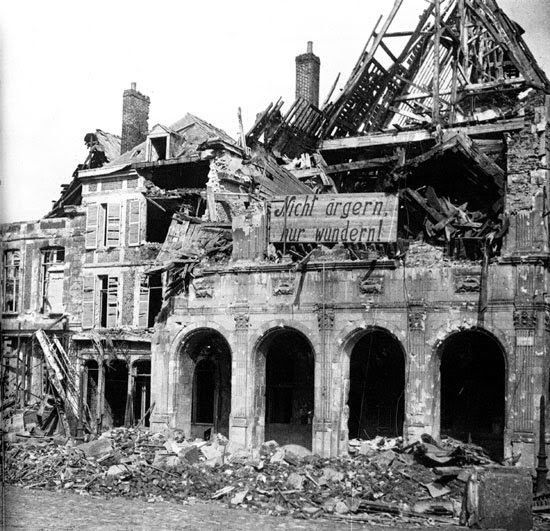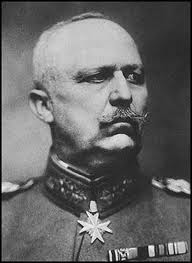 |
| Peronne, meet German Kultur |
In the spring of 1917 the Germans made an orderly withdrawal on the Western Front over the ravaged battlefield of the Somme. In some places they pulled back over 20 miles behind their original lines. The planned pullback was strategic move to remove kinks and curves in their original front line. By straightening the line they could save on precious man power and 13 divisions could be garnered for operations elsewhere, perhaps. The operation was performed with thorough Teutonic efficiency and the allies could do little to harry the German rear guard. Behind, the Germans left a wasteland. What couldn't be removed was destroyed. Whole towns and villages were consumed. Everywhere the Germans planted ingeniously fashioned booby traps.
The operation was also a tacit acknowledgement of defeat. The Somme battles of the preceding summer and autumn had severely mauled both the Allied and German armies. However, the Germans appreciated, that at the current rate of attrition, they would run out of men before the Allies did. They timed their manoeuvre to coincide with the inevitable Allied spring offensive and therefore the retreat had the added bonus of derailing the Allied initiative.
The new position was called the Hindenburg line after indomitable German general, Paul Von Hindenburg. In reality Hindenburg, at this stage of the war, was more a symbol of the mighty German nation than an effective war leader. The real power behind the lines remained with the German 'Quarter Master,' Ludendorff. Nonetheless, the new line was formidable and had been designed in depth. Interlocking defenses and redoubts could be swept with gun fire and machine gun turning the front into efficient kill zones. The lie of the land had been incorporated to ensure the entrenched Germans exploited everything to advantage. It was hoped that the Allied armies would bleed to death on the German wire whilst the German army conserved it's strength deep in dugouts to await the time of the Great German Offensive.
The withdrawal made sound military sense. The land the Germans occupied held no sentimental, or strategical value, to them. The giving up of land would increase the capacity of the German army to wage war and was a shrewd military move by the German High Command. However, it could not help but send a message to the German soldier on the front line, and even to the Allied High Command: 'Victorious armies do not retreat.' The adverse effect on German morale would not be immediately apparent and would have to await future battles before becoming manifest.
The Germans, of all people, should have learned the lesson from previous wars: There is no such thing as an impregnable defense especially against an aggressive and determined enemy.
In the town of Peronne, the Germans erected a whimsical sign on the side of the ruined town hall, it read: 'Don't be angry, be amazed'. And who said the Germans don't have a sense of humour! Today the sign resides in the museum of war, in Perronne.
 |
| Ludendorff, in repose |

No comments:
Post a Comment